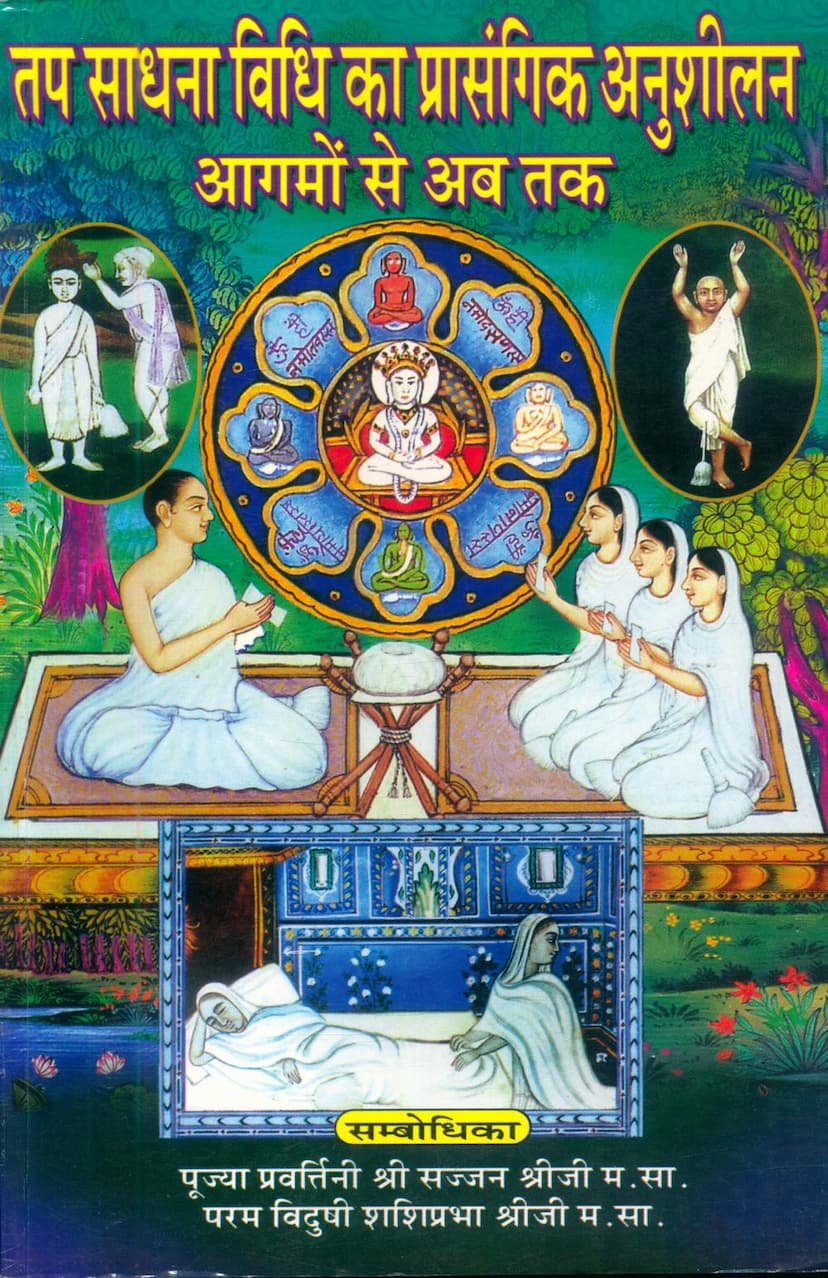Tap Sadhna Vidhi Ka Prasangik Anushilan Agamo Se Ab Tak
Added to library: September 2, 2025

Summary
This book, "तप साधना विधि का प्रासंगिक अनुशीलन आगमों से अब तक" (Tap Sadhna Vidhi Ka Prasangik Anushilan Agamo se Ab Tak) by Saumyagunashreeji, published by Prachya Vidyapith, is the ninth volume in the Sajjanmani Granthmala series. It is a comprehensive research work that delves into the various aspects of ascetic practices (tapas) in Jainism, tracing their evolution from ancient scriptures to the present day.
Here's a summary of the key themes and content covered in the book, based on the provided pages:
Core Subject:
The book's central theme is a detailed and comparative study of the methodology and principles of ascetic practices (tapas) in Jainism. It aims to provide a historical and analytical perspective on these practices, drawing from ancient Jain scriptures (Agams) and their subsequent interpretations and developments through different traditions and eras.
Key Areas Explored:
- Definition and Nature of Tapas: The book begins by exploring the various definitions and etymologies of the term "tapas" (asceticism) in Jain tradition. It discusses its core meaning as self-purification, austerity, and the burning of karmic matter.
- Classification of Tapas: It details the traditional Jain classification of tapas into two primary categories:
- Bahya Tapas (External Austerities): Practices that involve physical self-discipline, such as fasting (anashan), reduced consumption of food (unodari), alms-wandering (bhikshacharya), restricting intake of certain tastes or substances (rasparityag), physical hardship (kayaklesh), and controlled movement or sensory withdrawal (samleanata).
- Abhyantara Tapas (Internal Austerities): Practices focused on mental and spiritual purification, including expiation or confession of faults (prayschitta), humility and respect towards elders and scriptures (vinaya), service to the worthy and ailing (vaiyavrutti), scriptural study (swadhyay), meditation (dhyana), and detachment (vyutsarga).
- The Importance and Purpose of Tapas: The book emphasizes that tapas is not merely physical penance but a crucial means for karmic annihilation (nirjara) and spiritual purification, leading to liberation (moksha). It explains why tapas is considered essential for spiritual progress, even for liberated souls (Tirthankaras).
- Historical Evolution of Tapas: It traces how tapas practices have evolved over time, from the stringent austerities described in ancient Agams to the more nuanced and practical interpretations in later periods. The book highlights the influence of different Jain traditions (like Shwetambar and Digambar) on the understanding and practice of tapas.
- Specific Tapas Practices: A significant portion of the book is dedicated to detailing numerous specific types of tapas. It lists and explains various practices, including:
- External Austerities: Anashan (fasting) with its sub-categories like Bela, Tela, Chaumasa, Masakshaman, and various complex fasts like Ayambila, Pratima-based fasts (e.g., Bhikshu Pratima, Anangarathni), and specific rituals tied to lunar phases or seasons.
- Internal Austerities: Detailed explanations of the importance and practice of Prayschitta, Vinaya, Vaiyavrutti, Swadhyay, Dhyana, and Vyutsarga, highlighting their role in spiritual development.
- Comparative Study: The book compares the tapas traditions within Shwetambar and Digambar Jainism, noting similarities and differences. It also briefly touches upon the concept of austerity in other Indian religions like Hinduism and Buddhism, drawing parallels and distinctions.
- Methodology and Rituals: It outlines the procedures and rituals associated with undertaking tapas, including the auspicious timings, the role of the Guru in accepting vows, the etiquette during the practice, and the process of completing the vows (Udyapan).
- The "Why" and "How" of Tapas: The author addresses contemporary questions and skepticism regarding tapas, such as its relevance in modern times, the apparent contradiction between body discipline and spiritual liberation, and the scientific basis of fasting and austerity.
- The Role of Spiritual Guides: The book acknowledges the crucial guidance provided by spiritual preceptors (Gurus) like Acharya Shri Majjin Kailashsagar Surishwarji, Upadhyay Pramvar Shri Maniprabhsagarji, and the author's own spiritual mentors, Acharya Shri Sajjan Shriji and Acharya Shri Shashiprabha Shriji, underscoring the importance of their blessings and teachings in the journey of spiritual discipline.
- The Author's Journey: Interspersed within the academic discussion are glimpses into the author's own dedication and rigorous research process, spanning many years and involving extensive study and travel. The author, Sadhvi Saumyaguna Shri, is presented as a dedicated scholar and practitioner.
Key Takeaways:
- Holistic Approach: Jain tapas is presented not just as physical hardship but as a holistic discipline involving the body, mind, and speech, aimed at purification and liberation.
- Agamic Foundation: The research is deeply rooted in ancient Jain scriptures, providing an authentic and authoritative perspective.
- Practical Relevance: The book attempts to connect ancient practices with contemporary understanding, highlighting the enduring relevance of tapas for personal and spiritual well-being.
- Scholarly Depth: The work is a result of extensive research, indicated by its comprehensive nature, detailed classifications, and extensive bibliography.
In essence, "तप साधना विधि का प्रासंगिक अनुशीलन आगमों से अब तक" is a scholarly and devotional exploration of Jain asceticism, offering a deep dive into its scriptural basis, historical development, diverse practices, and profound spiritual significance. It serves as a valuable resource for anyone seeking to understand the intricate and vital role of tapas in the Jain path to liberation.